-
1. Solid State
11-
Crystalline & Amorphous Solid 50 minLecture1.1
-
Law of Crystallography 01 hourLecture1.2
-
Bravius lattice & Important Terms of solid state 48 minLecture1.3
-
Type of Cubic crystal & Closest packed St. 01 hourLecture1.4
-
Tetrahedral & Octahedral Void 38 minLecture1.5
-
Type of Voids & Radius Ratio 44 minLecture1.6
-
Type of ionic solid 59 minLecture1.7
-
Defect in Solid 48 minLecture1.8
-
Metallic Bonding 52 minLecture1.9
-
Chapter Notes – Solid StateLecture1.10
-
NCERT Solutions – Solid StateLecture1.11
-
-
2. Solution and its C.P
9-
Condition of solution formation, TD of Solution, Factors affecting solubility-Henary’s Law 55 minLecture2.1
-
Colligative Properties, Raoult’s Law 49 minLecture2.2
-
Relative lowering of V.P. & Problems 45 minLecture2.3
-
Non ideal solution, Azeotropic Solution 46 minLecture2.4
-
Elevation in B.P., Depression in F.P. 47 minLecture2.5
-
Osmotic Pressure, Abnormal C.P. & Van’t Hoff Factor 59 minLecture2.6
-
Solution – Ostwald Walker Exp. 13 minLecture2.7
-
Chapter Notes – Solution and its C.PLecture2.8
-
NCERT Solutions – Solution and its C.PLecture2.9
-
-
3. Chemical Kinetics
10-
Rate of reaction 37 minLecture3.1
-
Differential Rate Law 38 minLecture3.2
-
Integrated Rate Law 56 minLecture3.3
-
Integrated Rate problems 53 minLecture3.4
-
Pseudo order Reaction 40 minLecture3.5
-
Reaction Mechanism 47 minLecture3.6
-
Collision Model 34 minLecture3.7
-
Arhenius Equation 34 minLecture3.8
-
Chapter Notes – Chemical KineticsLecture3.9
-
NCERT Solutions – Chemical KineticsLecture3.10
-
-
4. Electrochemistry
13-
Introduction & Galvanic cell 32 minLecture4.1
-
Cell Notation & Cell Reaction 35 minLecture4.2
-
Electrode & Cell Potential 38 minLecture4.3
-
Electrochemical series 39 minLecture4.4
-
The Nernst Equation 39 minLecture4.5
-
Concentration cell, Battery, Corrosion 52 minLecture4.6
-
Electrolysis 20 minLecture4.7
-
Faraday Law 45 minLecture4.8
-
Resistance & Conductance 40 minLecture4.9
-
Molar & Eq. Conductance, Kohlraush’s Law 29 minLecture4.10
-
Problems on Resistance & Conductance 23 minLecture4.11
-
Chapter Notes – ElectrochemistryLecture4.12
-
NCERT Solutions – ElectrochemistryLecture4.13
-
-
5. Surface Chemistry
11-
Introduction & Surface tension & surface energy 33 minLecture5.1
-
Adsorption 47 minLecture5.2
-
Factors affecting Adsorption 39 minLecture5.3
-
Catalysis 34 minLecture5.4
-
Type of Catalysis & Enzyme Catalysis 41 minLecture5.5
-
Colloidal Solution 57 minLecture5.6
-
Type of Colloidal Solution 43 minLecture5.7
-
Properties of Colloidal Solution 50 minLecture5.8
-
Protective Colloids 58 minLecture5.9
-
Chapter Notes – Surface ChemistryLecture5.10
-
NCERT Solutions – Surface ChemistryLecture5.11
-
-
6. Alcohol & Ether
8-
Preparation 35 minLecture6.1
-
Physical Properties & Oxidation Of Alcohol 29 minLecture6.2
-
Hydrates, Acetal, Ketal 38 minLecture6.3
-
Tests Of Alcohol 47 minLecture6.4
-
Ether Preparation & Its Properties 33 minLecture6.5
-
Thiol & Thioether 16 minLecture6.6
-
Chapter Notes – Alcohol & EtherLecture6.7
-
NCERT Solutions – Alcohol & EtherLecture6.8
-
-
7. Aldehyde & Ketone
10-
Preparation 33 minLecture7.1
-
Physical Properties, Beckmann Rearrangement, Witting Reaction 46 minLecture7.2
-
Schmidt Reaction, Bayer Villegar Oxidation 22 minLecture7.3
-
Aldol Condensation Reaction 40 minLecture7.4
-
Cannizzaro Reaction 32 minLecture7.5
-
Acyloin, Benzoin, Clasien, Perkin Condensation 28 minLecture7.6
-
Reformasky Reaction, Tischenko Reaction 20 minLecture7.7
-
Tests-8 40 minLecture7.8
-
Chapter Notes – Aldehyde & KetoneLecture7.9
-
NCERT Solutions – Aldehyde & KetoneLecture7.10
-
-
8. Acid & derivatives
4-
Preparation 31 minLecture8.1
-
Chemical Reactions Of Acids 31 minLecture8.2
-
Arndt Eistert, Curtius, Hvz, Hoffmann Reaction 19 minLecture8.3
-
Acid Derivatives 38 minLecture8.4
-
-
9. Nitrogen containing compounds
4-
Alkyl Nitrites, Nitro Alkane 27 minLecture9.1
-
Alkane Nitrile & Isonitrile 20 minLecture9.2
-
Amine Preparation 24 minLecture9.3
-
Properties Of Amines 13 minLecture9.4
-
-
10. Aromatic Compounds
7-
Benzene 41 minLecture10.1
-
Aromatic Hydrocarbon 29 minLecture10.2
-
Aryl Halides 18 minLecture10.3
-
Phenol 40 minLecture10.4
-
Aromatic Aldehyde 39 minLecture10.5
-
Aniline 32 minLecture10.6
-
Phenyl Diazonium Salts 37 minLecture10.7
-
-
11. Biomolecules
14-
Introduction & Types Of Carbohydrates 47 minLecture11.1
-
D-glucose & D-fructose 50 minLecture11.2
-
Reactions Of D-glucose & D-fructose 32 minLecture11.3
-
Reactions Of D-glucose & D-fructose 23 minLecture11.4
-
Sucrose, Maltose, Lactose 31 minLecture11.5
-
Starch, Cellulose, Glycogen 27 minLecture11.6
-
Reducing Sugar, Mutarotation, Osazone Formation 40 minLecture11.7
-
Problems On Carbohydrates 41 minLecture11.8
-
Amino Acids 48 minLecture11.9
-
Peptides 47 minLecture11.10
-
Proteins 18 minLecture11.11
-
Enzyme & Vitamins 30 minLecture11.12
-
Nucleic Acid 36 minLecture11.13
-
Chapter Notes – BiomoleculesLecture11.14
-
-
12. Polymer Chemistry
6-
Polymerisation Addition Reaction 32 minLecture12.1
-
Coordination Addition, Condensation Reaction 24 minLecture12.2
-
Division Of Polymer 41 minLecture12.3
-
Examples Of Polymer 31 minLecture12.4
-
Examples Of Polymer 31 minLecture12.5
-
Chapter Notes – Polymer ChemistryLecture12.6
-
-
13. Practical Organic Chemistry
4-
Poc Qualitative Analysis 23 minLecture13.1
-
Poc Qualitative Analysis 20 minLecture13.2
-
Poc Quantitative Analysis 29 minLecture13.3
-
Poc Quantitative Analysis 20 minLecture13.4
-
-
14. P block elements II
13-
VA – Elemental Properties of N family 51 minLecture14.1
-
VA – Compounds of N family 43 minLecture14.2
-
VA – N & Its compounds 45 minLecture14.3
-
VA – Oxides & Oxyacids of Nitrogen 55 minLecture14.4
-
VA – P & its compounds 31 minLecture14.5
-
VA – Oxides & Oxyacids of P 31 minLecture14.6
-
VIA 1 – Elemental Properties of O-Family 36 minLecture14.7
-
VIA 2 – compounds of VIA elements 41 minLecture14.8
-
VIA 3 – Oxygen & Ozone 47 minLecture14.9
-
VIA 4 – Sulphur & oxides of Sulphur 37 minLecture14.10
-
VIA 5 – Sulphuric Acid 25 minLecture14.11
-
Chapter Notes – P block elementsLecture14.12
-
NCERT Solutions – P block elementsLecture14.13
-
-
15. P block elements III
5-
VIIA 1 – elemental properties of Halogen 40 minLecture15.1
-
VIIA 2 – Compounds of Halogen 49 minLecture15.2
-
VIIA 3 – Chlorine & its Compounds 41 minLecture15.3
-
VIIIA 1 – Properties of Noble Gas 34 minLecture15.4
-
VIIIA 2 – Compounds of Noble Gas 34 minLecture15.5
-
-
16. D block metals
8-
D block – Elemental Properties 55 minLecture16.1
-
Elemental Properties 01 hourLecture16.2
-
Elemental Properties 53 minLecture16.3
-
KMnO4 & K2Cr2O7 47 minLecture16.4
-
Problems 40 minLecture16.5
-
Problems 20 minLecture16.6
-
Chapter Notes – The d-and f-Block ElementsLecture16.7
-
NCERT Solutions – The d-and f-Block ElementsLecture16.8
-
-
17. F block metals
3-
Lanthanoids 52 minLecture17.1
-
Actinoids 48 minLecture17.2
-
Problems 42 minLecture17.3
-
-
18. Co-ordination compounds
17-
Introduction of Complex Compound, Ligands 42 minLecture18.1
-
Classification of Ligands, Denticity 35 minLecture18.2
-
Nomenclature of Complex Compounds 46 minLecture18.3
-
Nomenclature of Complex Compounds 2 40 minLecture18.4
-
Bonding in Complex Compound, Primary & Secondary Valency 44 minLecture18.5
-
Concept of EAN 29 minLecture18.6
-
VBT in Complex Compounds 58 minLecture18.7
-
Examples on VBT in complex compounds 31 minLecture18.8
-
CFT in Complex Compounds 43 minLecture18.9
-
CFT for Octahedral & Tetrahedral Complex 35 minLecture18.10
-
Colour & Stability of Complex Compounds 28 minLecture18.11
-
Structural Isomerism in Complex Compounds 49 minLecture18.12
-
Geometrical Isomerism in Complex Compounds 43 minLecture18.13
-
Optical Isomerism in Complex Compounds, use of Complex 01 hourLecture18.14
-
Organometallic Compounds 29 minLecture18.15
-
Chapter Notes – Co-ordination compoundsLecture18.16
-
NCERT Solutions – Co-ordination compoundsLecture18.17
-
-
19. Environmental Chemistry
4-
Introduction & Air Pollution 35 minLecture19.1
-
Air Pollution 20 minLecture19.2
-
Water Pollution 23 minLecture19.3
-
Soil Pollution, Prevention of Pollution 16 minLecture19.4
-
Chapter Notes – Solid State
Solids are the chemical substances which are characterised by define shape and volume, rigidity, high density, low compressibility. The constituent particles (atoms, molecules or ions) are closely packed and held together by strong interparticle forces
Types of Solids
The solids are of two types: Crystalline solids and amorphous solids.
Distinction Between Crystalline and Amorphous Solids
S.No Crystalline solid |
Amorphous solids |
| 1 These have definite and regular arrangement of the constituent particles in space. | These doesn’t have any regular arrangement of the constituent particles in space. |
| 2 These are true solids. | Theseare super cooled liquids or pseudo soilds. |
| 3 These have long order arrangement of the particles. | These have short order arrangement of particle. |
| 4 These are anisotropic in nature, i.e., their physical properties are different in different directions. | These are isotropic in nature i.e., their physical properties are same in all the directions. |
| 5 They have sharp melting points. | They melt over a certain range of temperature. |
| 6 They undergo a clean cleavage when cut. | They undergo irregular cleavage when cut. |
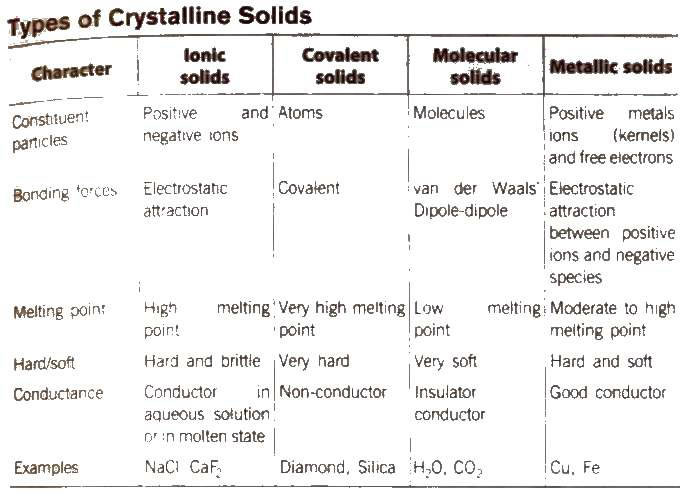
Structure Determination by X-ray Diffraction (Bragg’s Equation)
When a beam of X-rays falls on a crystal plane composed of regularly arranged atoms or ions, the X-rays are diffracted. If the waves are in phase after reflection, the difference in distance travelled by the two rays ti.e., path difference) must be equal to an integral number of Wavelength, nλ for constructive.
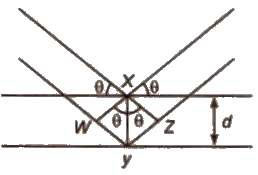
Thus, path difference = WY + YZ
= XY sin θ + xy sin θ
= 2 XY sin θ = 2d sin θ
∴ nλ = 2d sin θ
This equation is called Bragg’s equation.
Where, n = 1. 2, 3… (diffraction order)
λ = wavelength of X·rays incident on crystal
d = distance between atomic planes
θ = angle at which interference occurs.
Unit Cell
The smallest geometrical portion of the crystal lattice which can be used as repetitive unit to build up the whole crystal is called unit cell.
Types of Unit Cell
(i) Simple or primitive Unit cell
In which the particles are present at the corners only.
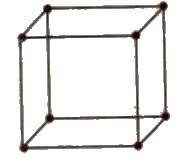
(ii) Face centred unit cell
In which the particles are present at the corners as well as at the centre of each of six faces

(iii) Body centred unit cell
In which the particles are present at the corners as well as at the centre of the unit cell.
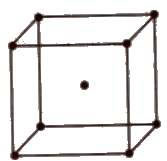
(iv) End centred unit cell
In which the particles are present at the corners and at the centre of two opposite faces.
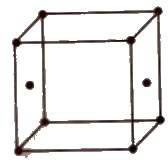
Number of Particles Per Unit Cell
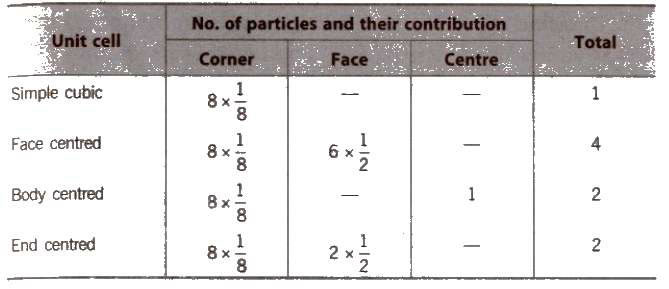
Seven Crystal Systems
There are about 230 crystal forms, which have been grouped into 14 types of space lattices, called Bravais Lattices, on the basis of their symmetry and seven different crystal systems on the basis of interfacial angles and axes.
Seven Crystal Systems

Packing Fraction
It is defined as the ratio of the volume of the unit cell that is occupied by the spheres to the volume of the unit cell.
(i) Primitive cubic unit cell
Atoms touch each other along edges.
Hence, d = a or r = a / 2
(r = radius of atom and a = edge length)
Therefore, PF = 4 / 3 πr3 / (2r)3 = 0.524 or 52.4%
(ii) Face centred cubic unit
cell Atoms touch each other along the face diagonal.
Hence, d = a / √2
or r = √2a / 4
Therefore; PF = 4 * 4 / 3 πr3 / (4r / √2)r3 = 0.74 or 74%
(iii) Body centred cubic unit
cell Atoms touch each other along the body diagonal.
Hence, √3a / 2
or r = √3a / 4
Therefore; PF = 2 * 4 / 3 πr3 / (4r / √3)r3 = 0.68 or 68%
Coordination Number
It is defined as the number of particles immediately adjacent to each particle in the crystal lattice.
[In simple cubic lattice, CN is 6, in body centred lattice, CN is 8 and in face centred cubic lattice, CN is 12].
High pressure increases CN and high temperature decreases the CN.
Close Packing in Crystals
Two Dimensional Packing of Constituent Particles
(i) Square close packing
Space occupied by spheres is 52.4%.
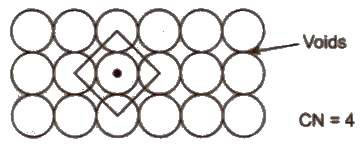
(ii) Hexagonal close packing
Space occupied by spheres is 60.4%.Hence. It is more efficient.
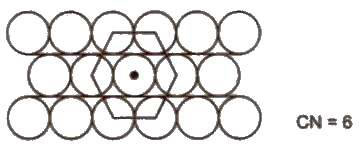
Three Dimensional Packing of Constituent Particles
(i) ABAB arrangement gives hexagonal close packing (hcp).
(ii) ABCABC arrangement gives cubic close packing or face centred CUbIC packing (ccp or fcc).
• In both these arrangements 740/0 space is occupied
• Coordination number in hop and ccp arrangement is 12 while in bcc arrangement, it is 8.
• Close packing of atoms in cubic structure = fcc > bcc > sc.
• All noble gases have ccp structure except He (hcp structure).
Void or Space or Holes
• Empty or vacant space present bet veen spheres of a unit cell, is called void or space or hole or interstitial void. When particles are closed packed resulting in either cpp or hcp structure, two types of voids are generated:
• Tetrahedral voids are holes or voids surrounded by four spheres Present at the corner of a tetrahedron. Coordination number of a tetrahedral void is 4.

• Octahedral voids are holes surrounded by six spheres located on a regular tetrahedron. Coordination number of octahedral void is 6.

[The number of octahedral voids present in a lattice is equal to the number of close packed particles. The number of tetrahedral voids present in a lattice is twice to the number of close packed particles.]
Density of Unit Cell (d)
Density of unit ce11 = mass of unit cell / volume of unit cell
d = Z * M / a3 = ZM / a3 * NA
(The density of the unit cell is same as the density of the substance.)
where, d = density of unit cell
M = molecular weight
Z = no. of atoms per unit cell
NA = Avogadro number
a = edge length of unit cell.
The Structure of Ionic Crystals
The ionic radius ratios of cation and anion, play a very important role in giving a clue to the nature of the crystal structure of ionic substances.
Radius Ratio and Crystal Structure

Ionic crystals may be of two types
(i)AB type and
(ii) A2B or AB2
Structure of Ionic Crystals
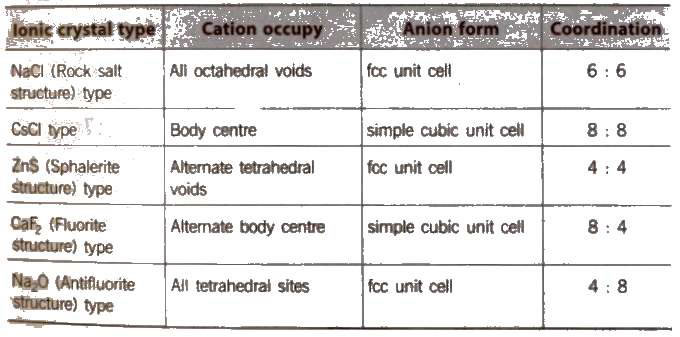
On applying pressure NaC} structure (6 : 6 coordination) changes into CsCI structure (8 : 8 coordination) and reverse of this occur at high temperature (760 K).
Imperfections in Solids
• In a crystalline solid, the atoms, ions and molecules are arranged in a Definite repeating pattern, but some defects may occur in the pattern. derivations from perfect arrangement may occur due to rapid cooling or presence of additional particles.
• The defects are of two types, namely point defects and line defects.
Point Defects
Point defects are the irregularities or deviations from ideal arrangement around a point or an atom in a crystalline substance Point defects can be classified into three types : (1) psychometric defects (2) impurity defects (3) non–stoichiometric defects
1. Stoichiometric Defect
These are point defects that do not disturb’ the -stoichiometric of the solid. They are also called intrinsic or thermodynamic defects. In ionic solids, basically these are of two types, Frankel defect and Schottky defect

AgBr has both Schottky and Frenkel defects. Frenkel defects are not found in pure alkali metal halides because cations are of large size.
2. Impurity Defect
• It arises when foreign atoms or ions aloe present in the lattice. In case of ionic compounds, the impurity 1S also ionic in nature. When the impurity has the same charge as the host ion. it just substitutes some of the host ions.
• Impurity defects can also be introduced by adding impurity ions having different charge than host ions. e.g. molten NaCl containing a little amount of SrCI2 is crystallised. In such cases,
• Cationic vacancies produced = [number of cations of higher valence * Difference in valence of the host cation and cation of higher valence
3. Non-Stoichiometric Defect
Non-stoichiometric crystals are those which do not obey the law of constant proportions. The numbers of positive and negative ions present in such compounds are different from those expected from their ideal chemical formulae. However, the crystal as a whole in neutral.
Types of n-stoichiometric defects are as follows:
(i) Met excess defect
Metal excess defect due to anionic vacancies: Alkyl halides like NaC1 and KCl show this type of defect. centres ale the sites from where anions are missing and the vacant sites are occupied by electrons. F-centres contribute colour and paramagnetic nature of the crystal [F stands for German wo\d Farbe meaning colour).
Metal excess defect due to presence of extra cations at interstitial sites, e.g., zinc oxide is white in colour at room temperature. On beating, it loses oxygen and turns yellow.

(ii) Metal deficiency defect due to cation vacancy It is due to the absence of a metal ion from its lattice site and charge is balanced by ion having higher positive charge. Transition metals exhibit this defect, e.g., FeO, which is found in the composition range from Fe0.93 O to Fe0.96O.
In crystal of FeO, some Fe2+cations are missing and the loss of positive charge is made up by the presence of required number of Fe3+ ions.
Classification of Solids on the Basis of Electrical Conductivity

[The electricity produced on heating a polar crystal is called ‘pyroelectricity’.]
When mechanical stress is applied on polar crystals, electricity produced due to displacement of ions is called ‘piezoelectricity’
Semiconductors
Electronic conductors having electrical conductivity in the range of 104 – 107 Ω-1 cm-1 are known as semiconductors. Examples Si, Ge Sn (grey), Cu2O, SiC and GaAs.
Intrinsic Semiconductors
Pure substances that are semiconductors are known as Intrinsic Semiconductors e.g., Si, Ge
Extrinsic Semiconductors
Their conductivity is due to the presence of impurities. They are formed by doping. It is defined as addition of impurities to a semiconductor to increase the conductivity. Doping of Si or Ge is carried out with P, As, Sb, B, Al or Ga.
(i) n·type semiconductors Silicon doped with 15 group elements like phosphorus is called ntype semiconductor. The conductivity is due to the presence of negative charge (electrons),
(ii) p·type semiconductors Silicon doped with 13 group element like gallium is called p-type semiconductor. The conductivity is due to the presence of positive holes.
• Some typical 13-15 compounds are InSb, AlP and GaAs and SOme typical 12-16 compounds are ZnS, CdS. CdSe and HgTe.
• These exhibit electrical and optical properties of great use in electronic industry.
Magnetic Properties of Solids
Solids can be divided into different classes depending on their response to magnetic field.
1. Diamagnetic Substances
These are weakly repelled by the magnetic field and do not have any unpaired electron, e.g., TiO2, V2O5, C6H6, NaCI, etc.
2. Paramagnetic Substances
These are attracted by the magnetic field and have unpaired electrons These lose magnetism in the absence of magnetic field, e.g., O2, Cu2+, Fe3+, etc.
3. Ferromagnetic Substances
These are attracted by the magnetic field and show permanent magnetism even ill the absence of magnetic field e.g., Fe, Co and Ni.
4. Anti-ferromagnetic Substances
These substances have net magnetic moment zero due to compensatory alignment of magnetic . moments, e.g., MnO, MnO2, FeO, etc.
5. Ferrimagnetic Substances
These substances have a net dipole moment due to unequal parallel and anti-parallel alignment of magnetic moments, e.g., Fe3O4, ferrites, etc.
